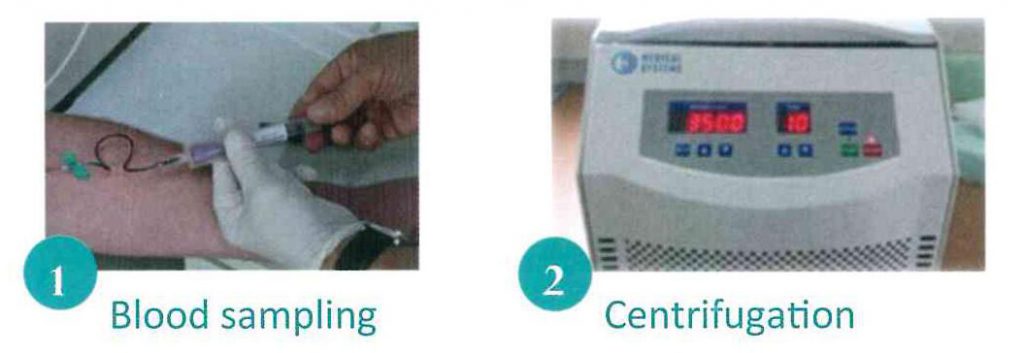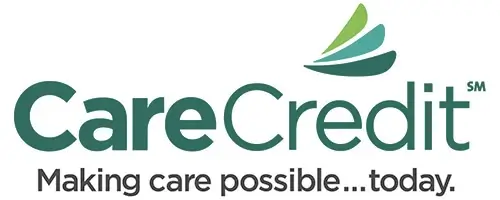Overview
As one of the first clinics worldwide, we are offering a new therapeutic approach: Highly innovative Low-Level Laser Therapy.
This brochure aims to provide an overview of its various fields of application.
Please do not hesitate to contact our clinic team should you have questions!
About Low-Level-Laser Therapy (LLLT)
The therapy concept of LLLT has been developed in Germany and is based on the usage of soft lasers. Unlike surgical lasers that destroy tissue and celss, soft lasers supply our body with energy to trigger numerous regenerative processes.
Medical laser therapy applies blue, green, yellow, red and infrared lasers. Each color develops different effects which are evoked by the stimulation of specific cellular components, such as growth factors or cells of our immune system.
These effects have been proven by a large number of clinical studies.
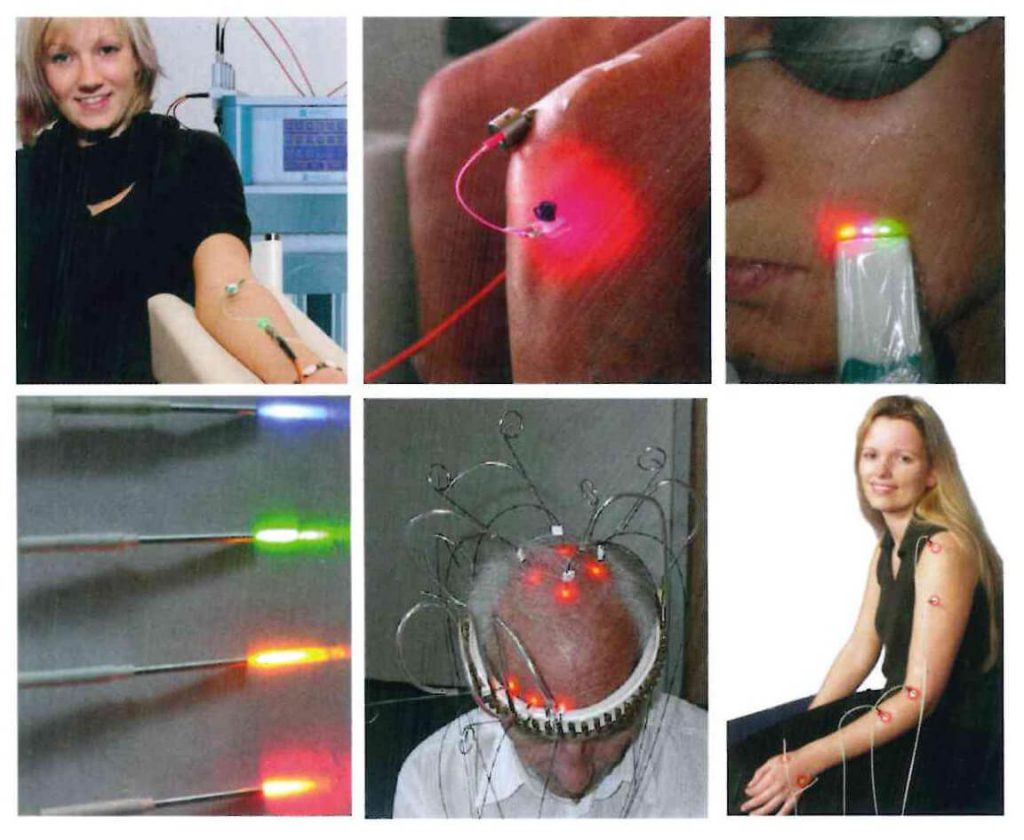
Areas of application (For details, please refer to the following pages)
What we offer:
- Local Laser Therapy (non-invasive)
- Laserneedle Acupuncture
- Transcranial Laser Therapy
- Dermatological Therapy
- Cosmetic Laser Therapy
- Interstitial Laser Therapy
- Intra-articlular Laser Therapy
- Platelet-Rich-Plasma (PRP) and Laser Therapy
- Intravenous Laser Therapy
- Photodynamic Tumor Therapy
- External
Local Laser Therapy (non-invasive) and Laserneedle Acupuncture
External Laser Therapy applies up to twelve so-called laserneedles simultaneously.
They are not inserted into the skin, but only attached externally. These needle-like laser ends have the ability to achieve a high energy density that can penetrate directly into the body to stimulate pain areas and develop healing mechanisms.
Medical laser therapy applies blue, green, yellow, red and infrared lasers. The tissue absorbs the colors respective wavelengths to different degrees, and thus each solor has a different penetration depth. This even facilitates the irradiation of deep tissue.
Laserneedles can also be used for traditional acupuncture. The procedure is pain-free and opens up the possiblity to stimulate twelve acupuncture points at the same time. In addition, patients benefit from the healing effects of high-energy light particles.
This pain-free and non-invasive method achieves excellent treatment results by verifiable tissue irritation.
Areas of application:
- Pain Therapy
- Rehabilitation
- Acupuncture: All indications of traditional acupuncture, such as spine syndromes, arthrosis, slipped disc, rheumatic diseases, tendinitis, trigeminal neuralgia, depressions, MS, gastrointestinal diseases, allergies, asthma, hypertension, diabetes.


Transcranial Laser Therapy
Transcranial laser therapy stimulates various neurological processes which makes it an innovative and promising new treatment option for the post-treatment of strokes, the treatment of parkinson’s, Alzheimer’s, cerebral sclerosis, migraine, vertigo, tinnitus and other degenerative cerebral disorders.
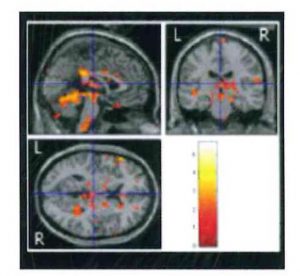
Effects:
- Reduction of the infarct region and improved circulation
- Activation of neuronal growth
- Improvement of neurological skills and cognitive deficits
- Positive effects on inflammatory processes in the brain
- Reparative effects concerning neuronal functions

Dermatological Laser Therapy
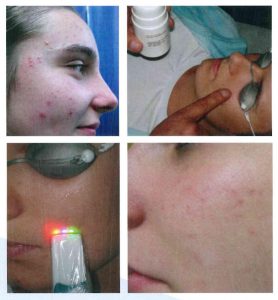
In dermatology laser therapy is well established to treat various kinds of eczemas, neurodermatitis, psoriasis, chronical wounds, acne vulgaris, herpes, hyperkeratosis, warts, gingivitis and other skin diseases. Skin cancer and its pre-stages can also be treated very successfully.
Due to their anti-bacterial and anti-inflammatory effects, blue lasers are highly effective.
Therapy results can be improved by using special photosensitive creams, such as 5-ALA or green tea lotions.
Interstital Laser Therapy
In order to bring even more laser light into low-lying tissue layers, a new technique, the percutaneous interstitial laser therapy, was developed. By using a sterile catherter it reaches penetration depths of up to 12 cm.
Compared to external laser therapy, this technique has significantly improved therapeutic results.
Also green, yellow and blue lasers, which are normally absorbed already in the surface of the skin can be applied into deep tissue where they develop their anti-inflammatory effects.
Areas of application:
- Chronic spinal disorders
- Herniated discs
- Scar pain after disc surgery
- Spinal stenosis
- Nerve lesions
- Tendonitis and strains
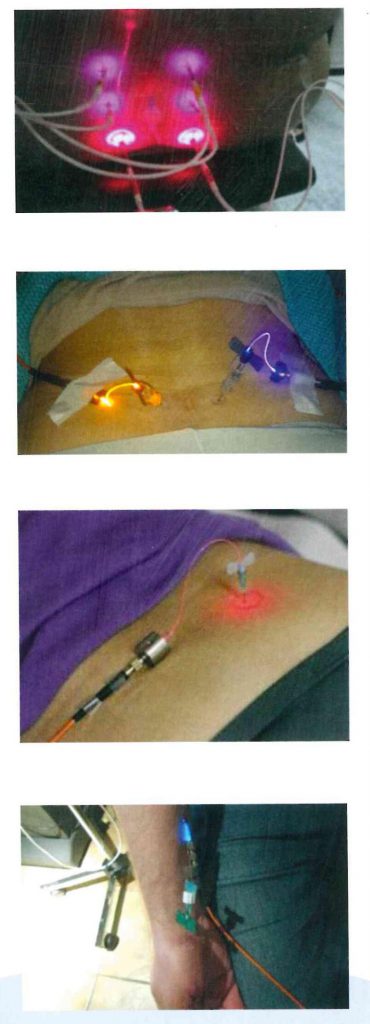
Intra-articular Laser Therapy
Intra-articular laser therapy is used primarily in the treatment of damaged joints by application of the newly developed catheter technology. It allows derect irradiation of dysfunctional tissue (e.g., nerves, cartilages, bones).
There are already many scientific studies that clearly demonstrate the regeneration of cartilage tissue by means of Low-Level Laser Therapy.
While red lasers are mainly used for reganeration in chronic joint pain, blue light is particularly effective in the treatment of acute inflammation.
To optimize effects, the treatment may also be combined very successfully with other injection therapies (e.g., Platelet-rich plasme: see next page).
Areas of application:
- Knee joint arthrosis
- Hip arthrosis
- Chronic shouler syndrome
- Ankle arthrosis
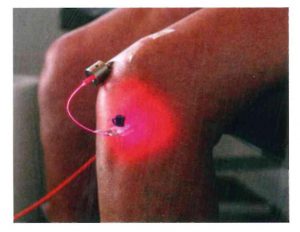

Laser Therapy in Combination with Platelet Rich Plasma (PRP)
Platelet or therombocyte-rich plasma (PRP) can be obtained from the patient’s own blood very easily. After blood sampling with special tubes (8-30 ml), PRP is prepared by centrifugation and is injected into demaged tissue.
Platelets contain a high amount of tissue-reganerating growth factors and cytokines.
They stimulate cell reproduction, angiogenesis and the formation of connective tissue.
The PRP injection can be combined very successfully with laser therapy, taking advantage of the reganerative effects of the laser irradiation and thus obtaining even better treatment results.
Due to its analgesic, anti-inflammatory and wound-healing effects, this reatment can improve verious conditions.
Areas of application:
- Orthopedics (arthrosis, bone regeneration)
- Sports Medicine (tendinopathy, fractures, wound healing)
- Aesthetic Medicine (skin rejuvenation, scar treatment, hair loss)
PRP and Laser for Skin Rejuvenation
Especially in the field of Aesthetic Medicine, PRP therapy is becoming ever more popular. It is also known under terms such as Dracula Therapy or Vampire Facelift. PRP treatments stimulate the skin not only superficially, but also in depth.

While fillers such as Botox or hyaluronic acid are very limited in efficiency and degrade after only three months, PRP injections are a gentle method to increase volume:
They are free of side effects as only autogenous cells are used as filler.
The results are long-lasting and natural.
Subsequent treatment with laser light enhances the reganerative effects so that the results are even more remarkable.
The volume increase improves facial contours. The skin looks rejuvenated and revitalized.
Intravenous Laser Therapy
Intravenous Laser Therapy enables the application of laser light directly into the bloodstream by using a special catherter technology. The laser light stimulates circulating blood cells and stem cells.
Various laboratory tests and clinical data show that the irradiation of blood cells and triggers a number of positive effects.
The technology is more than 30 years old. It was officially approved in Germany in 2005. Today, numerous international private practices and clinics use intravenous laser therapy.
Universities have also recognized the potential of this therapy method and made it the focus of their research.
- Energizing effects (increases ATP production), strengthens the immune system, increases cell activity, regenerates damaged tissue structures, and improves circulation.
- Increases oxygen uptake, reduces pain caused by inflammation and swelling.
- Improves microcirculation by NO release, strong anti-inflammatory, and antibacterial effects accelerate wound healing, supports pain relief, activates telomerase and biogenesis of mitochondria with maximum anti-aging effects.
- Antidepressant effects by enhancement of vitamin D and serotonin production, effective against chronic (viral) infections, strong antibacterial effects, positive influence on endocrine system and metabolism.
Areas of application:
- Internal diseases (diabetes mellitus, chronic liver and kidney diseases)
- Metabolic disorders
- Cardiovascular diseases
- Chronic pain
- Fibromyalgia and rheumatism
- Allergies
- Macular degeneration
- Tinnitus
- Multiple sclerosis
- Depression and burn-out
- Lyme disease
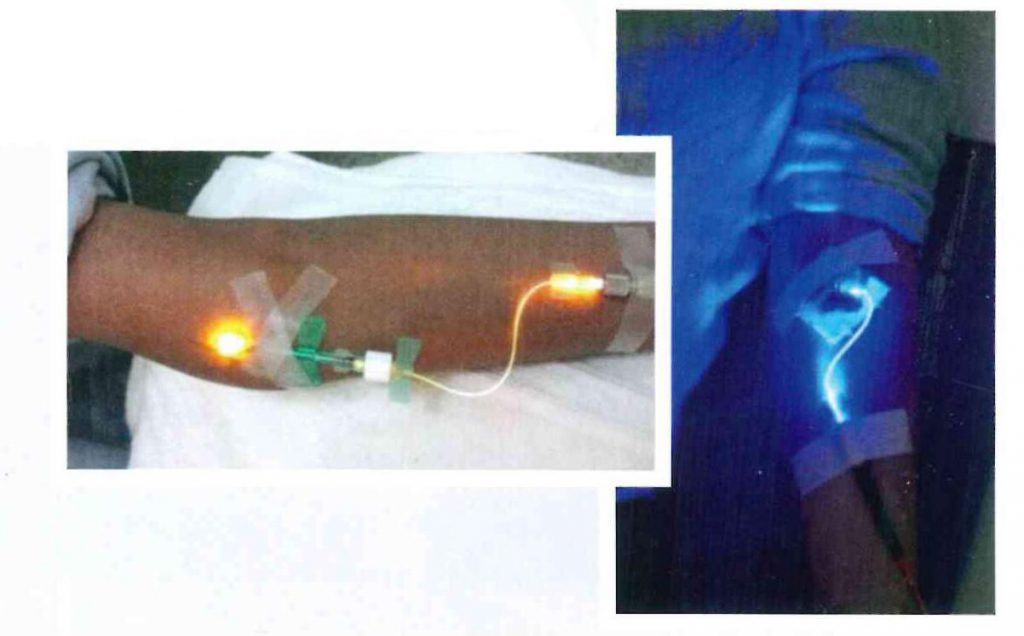
Photodynamic Tumor Therapy (PDT)
Photodynamic Therapy (PDT) is one of the most interesting and promising therapeutic approaches in the treatment of varous tumor diseases.
The method is based on the stimulation of a light-sensitive substance (photosensitizer). It is either applied to the sin in the form of a cream, given into the bloodstream by infusion and /or is injected locally into the tumor.
The photosensitizing agent binds to any kind of tumor cells that are present in the body. After excitation with (laser) light, these are destroyed by formation of active oxygen radicals.
An essential advantage over traditional chemotherapy is that the immune system is not weakened, but strengthened by the positive effects of intravenous laser therapy. In addition, secondary immunization effects appear (PDT – immunization).
Photodynamic Therapy may also be combined very effectively with low-dose chemotherapy. There are even chemotherapeutics on the market that can be stimulated by laser therapy. Compared to standard chemotherapy, the side effects are significantly lower.
External PDT for the Treatment of Skin Cancer

For the treatment of basal cell Carcinoma or keratosis a special cream with light-sensitive substances (e.g., 5-ALA) is applied locally to the affected skin area.
Anti-microbial Photodynamic Therapy
Anti-microbial Photodynamic Therapy (aPDT) aims to kill bacterial, viral and parasitic pathogens. The procedure is very similar to the one used in Photodynamic Tumor Therapy. Instead of tumor tissue, photosensitizers bind to pathogens.
Riboflavin, Hypericin and Curcumin are used as photosensitizers (orally or by infusion). They are “activated” by local or systemic laser therapy to fight the pathogens either locally or in the bloodstream.
In principle, all bacterial, viral or parasitic diseases can be treated by means of PDT.
The great advantage of the therapy is that it even kills mulitresistant pathogens.
Indications:
- Viral diseases (hepatitis, HIV, herpes, etc.)
- Bacterial infections
- Multiresistant staphylococci
- Parasitic diseases
- Lyme disease
Riboflavin and Curcumin are stimulated with blue light, while Hypericin which is derived from St. John’s wort, reacts to yellow light.

Systemic and Interstitial PDT
The light-sensitive photosensitzer is administered by infusion and activated through systemic (intravenous) laser therapy.
After about 2-3 hours, the photosensitizer binds selectively to the tumor. The laser can now irradiate and destroy the diseased tissue locally (interstitially, endoscopically or with special catheter technique).
The photosentsitizers (Indocyanine green, Chlorin E6, Curcumin and Hypericin) are Highly specific and natural. Side effects are therefore relatively low.
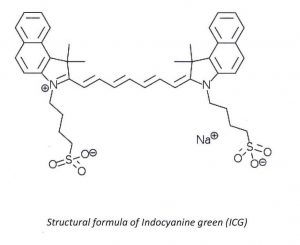

Disclaimer of Medical Advice:
All of the content provided on the website, including text, treatments, dosages, outcomes, charts, profiles, graphics, photographs, images, videos as well as other forms of media, advice, messages, and forum postings, are for informational purposes only and DOES NOT CONSTITUTE THE PROVIDING OF MEDICAL ADVICE and is not intended to be a substitute for independent professional medical judgment, advice, diagnosis, or treatment.
The content is not intended to establish a standard of care to be followed by a user of the website. You understand and acknowledge that you should always seek the advice of your physician or other qualified health provider with any questions or concerns you may have regarding your health. You also understand and acknowledge that you should never disregard or delay seeking medical advice relating to treatment or standard of care because of information contained in or transmitted through the website.
Medical information changes constantly. Therefore, the information on this website or on the linked websites should not be considered current, complete or exhaustive, nor should you rely on such information to recommend a course of treatment for you or any other individual. Reliance on any information provided on this website or any linked websites is solely at your own risk.
ICAM does not recommend or endorse any specific tests, products, procedures, opinions or other information that may be provided on the linked websites. The linked websites may contain text, graphics, images or information that you find offensive. ICAM, its licensors and its suppliers have no control over and accept no responsibility for such materials. You understand and acknowledge that all users of this website are responsible for their own medical care, treatment, and oversight.

